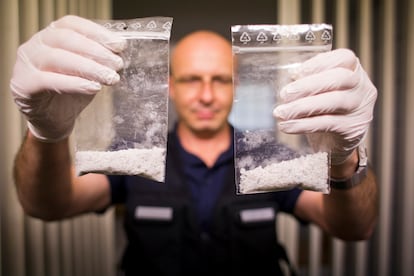Methamphetamine boom worries Europeans
The European Monitoring Centre for Drugs and Drug Addiction warns of the growing market for the highly addictive drug that can cause symptoms of psychosis

Methamphetamine, an addictive and harmful stimulant, was once legal and used everywhere. In Germany, it was sold as Pervitin and used by secretaries to type faster, new mothers to alleviate postpartum depression, truck drivers to fight fatigue, and even by the Nazi army during its Blitzkrieg lightning strikes through France. In Blitzed: Drugs in the Third Reich (2018), author Norman Ohler writes that in 1930s Germany, methamphetamine was an all-purpose panacea. “Whatever the ailment, the Germans always used the little blue, white and red tube of Pervitin,” writes Ohler. It may have even helped the Nazis almost win World War II.
Today, methamphetamine is considered a highly dangerous and destructive drug, just behind heroin and crack. The potent synthetic stimulant can lead to severe dependence and serious cardiac and psychosis symptoms. Pervitin no longer exists, but the substance continues circulating on streets worldwide in powder, pill and crystal form that users inhale, smoke or inject. The drug once abused by Hitler’s troops is now causing concern among European health officials. A European Monitoring Centre for Drugs and Drug Addiction (EMCDDA) report warned last year that “the user market in Europe is relatively small, but could be growing.”
All signs are pointing in that direction. “The threat posed by methamphetamine appeared to be increasing as the drug spread to new markets elsewhere in Europe,” said the EMCDDA report. Andrew Cunningham, EMCDDA’s drug markets and crime lead, told EL PAÍS that methamphetamine “is the most widely used synthetic stimulant in the world,” and although “Europe remains a relatively small market compared to Asia, North America and Australia, there is concern that it may be growing here.”
Most meth consumption has historically been concentrated in the Czech Republic and Slovakia, but there are “signs of growing use in some other countries,” warns Cunningham. A recent study of European city wastewater reported higher traces of methamphetamine in Belgium, eastern Germany, Spain, Cyprus and Turkey and several northern European countries. “Of the 60 cities with data for 2021 and 2022, almost two-thirds (39) reported an increase in residues,” stated the report.
Data from supervised drug consumption rooms in Barcelona and Oslo indicate rising methamphetamine use. “In Athens, there have also been reports of the growing “sisa” (crystal meth) problem,” said Cunningham. Arrests for possession or use of methamphetamine also rose from 2015-2020.
The number of new patients starting detoxification treatment is another closely watched indicator. Cunningham says that while detoxification for methamphetamine addiction remains low compared to other substances, there has been “a gradual increase” since 2015 in most countries with available data. In 2015, 14 European countries reported that 637 people started meth treatment; in 2020, it was up 25% to 797 individuals.
Methamphetamine is considered a highly dangerous and destructive drug, just behind heroin and crack
During an EMCDDA webinar in early March, researchers from Barcelona said meth consumption is low compared to other drugs but is trending upward. Ester Aranda, deputy director for drug abuse with a Spanish NGO for underserved communities (Asociación Bienestar y Desarrollo - ABD), said, “It [methamphetamine] has been detected mainly in Madrid and Barcelona, but this doesn’t mean it’s not in other cities. For example, Barcelona has had wastewater analysis in place since 2011, which enables it to monitor [substances]. We have detected slight increases in methamphetamine since 2017-2018 in particular populations.” ABD manages one of the largest drug addiction centers in the city – CAS Baluard – on behalf of the Barcelona Public Health Agency (ASPB).
The more carefully you look, the more you find. The ASPB’s monitoring systems noted slight increases in meth use over the past few years. In 2016, 31 Barcelona residents started methamphetamine addiction treatment; in 2021, the number rose to 133. Since 2019, CAS Baluard has implemented various harm reduction services, including a program that supplies meth smoking pipes, which is how most Barcelona users consume the drug. In 2021, ASPB recorded 3,000 visits (6% of the total) to supervised consumption rooms (one person can make multiple visits) for methamphetamine. In 2022, the number of visits for meth consumption rose to 3,900 (6.6% of the total).
“If we look at all the people who come to these supervised consumption rooms, methamphetamine is a tiny proportion, but we must always be proactive,” said Montse Bartroli, ASPB’s head of Drug Dependency Care. Preparation is essential, especially in light of the experiences of other countries, where the exponential surge in deaths due to methamphetamine overdose continues to worry public health experts.
Mired in an unrelenting opioid overdose crisis , the United States reported unprecedented fatalities from methamphetamine from 1999-2021. During those two decades, 135,000 people died from meth overdoses, and about 43% also involved heroin or fentanyl.
A devastating drug
Despite the notoriety gained from the Breaking Bad television series, where a high school chemistry professor Walter White cooked up enormous batches of the drug in an old RV, methamphetamine is devastating to physical and mental health. “It’s a very potent stimulant. It easily traverses the blood-brain barrier [which protects the brain] and has a dopamine-releasing effect,” said Rosa Sauras, a psychiatrist at the Dual Pathology Unit of the Hospital del Mar in Barcelona. “It produces energy and euphoria and speeds up the body... Unlike other substances, there is a risk of experiencing prolonged psychotic breaks. Some people end up with schizophrenia diagnoses due to persistent symptoms.”
They call it chalk, crank, shabu, ice, crystal, glass, ice or tweak on the streets. According to Spain’s National Drug Plan, methamphetamine causes short-term loss of appetite, increased heart and respiratory rate, and psychiatric effects, such as paranoia, anxiety, insomnia, panic attacks and aggressive behavior. Besides addiction, long-term effects include persistent psychiatric symptoms such as visual and auditory hallucinations or delusions that can reappear during stress.
The Hospital del Mar in Barcelona has reported increased emergency room admissions for several years of methamphetamine-related overdoses and cardiac and psychiatric problems. “We provide psychiatric care in three facilities,” said Sauras. “We have seen a slow increase in the drug dependency center, where [methamphetamine] users are reluctant to ask for help. We also have a consultation service for seeing patients admitted to other parts of the hospital. For example, the cardiology department notifies us when it detects drug abuse. In the dual pathology unit, we see patients experiencing persistent hallucinations or psychotic breaks after being admitted to the psychiatric emergency department for urgent treatment.” This unit has gone from seeing a couple of methamphetamine-related cases a year to two every month.
We see patients experiencing persistent hallucinations or psychotic breaks after being admitted to the psychiatric emergency department for urgent treatmentRosa Sauras, a psychiatrist at the Hospital del Mar in Barcelona
The profile of a methamphetamine user is diverse and has changed over the years, says Dr. Sauras. “Our first cases in 2016 were people from the Filipino community who smoked it to work longer and harder.” Now habitual users of other substances are combining them with methamphetamine. It has also become popular in “chemsex, " the consumption of drugs to facilitate or enhance sexual activity, usually among gay men. The drug is also used recreationally and by people in highly vulnerable environments, such as those living on the streets.
Researchers at the Barcelona Hospital Clínic studied the effects of methamphetamine on the mental health of chemsex users in 50 patients. They found that 80% ultimately went to the addiction unit for meth abuse. Most of the time, the drug was smoked, and over 33% of the study group displayed symptoms of psychosis. “Barcelona is a hotbed of chemsex, and methamphetamine is one of the most commonly used drugs for that activity. Its use has spread through chemsex,” said Lorena de la Mora, one of the study’s authors. “We are seeing the consequences of prolonged methamphetamine use [during chemsex], such as psychotic disorders and the psychological deficits and neurotoxicity caused by this substance,” said de la Mora.
Attacking the drug supply
A therapeutic approach is complex because “there is no specific pharmacological treatment,” said Sauras. It’s also difficult for people to stick with the therapy. “People usually come to the hospital in bad condition and find it very difficult to emotionally connect with the treatment center. For example, drug use is highly stigmatized in the Filipino community. We also encounter language barriers and ignorance about the healthcare system,” she said.
Adherence to the health care resource is crucial, says ASPB’s Montse Bartroli. “Our harm reduction efforts include prevention of compulsive, unsafe consumption, and we try to work with individuals to get them into treatment when ready.” ABD’s Ester Aranda says Barcelona’s healthcare infrastructure is ready to deal with the rising number of cases, which gives her peace of mind.
Another focus is “attacking the supply,” said Bartroli. This is what worries Andrew Cunningham. “Europe is a destination and transit point for methamphetamine produced in Iran, Nigeria, and, more recently, Mexico,” he said. Industrical-scale production of methamphetamine in Europe has grown and become more sophisticated. Production is also increasing in Afghanistan (the primary heroin source for Europe), which poses “a potential threat” to the EU, says Cunningham.
If methamphetamine use in Europe continues to surge, it will snowball into other problems and cause serious health consequences. “We face a potential increase in serious violence, expansion of organized crime, corruption and money laundering,” said Cunningham. Although there is no data on how this will evolve, he is not very optimistic. “There’s concern about a larger, more diverse group of users, with serious consequences for the health and safety of Europeans.”
Sign up for our weekly newsletter to get more English-language news coverage from EL PAÍS USA Edition
Tu suscripción se está usando en otro dispositivo
¿Quieres añadir otro usuario a tu suscripción?
Si continúas leyendo en este dispositivo, no se podrá leer en el otro.
FlechaTu suscripción se está usando en otro dispositivo y solo puedes acceder a EL PAÍS desde un dispositivo a la vez.
Si quieres compartir tu cuenta, cambia tu suscripción a la modalidad Premium, así podrás añadir otro usuario. Cada uno accederá con su propia cuenta de email, lo que os permitirá personalizar vuestra experiencia en EL PAÍS.
¿Tienes una suscripción de empresa? Accede aquí para contratar más cuentas.
En el caso de no saber quién está usando tu cuenta, te recomendamos cambiar tu contraseña aquí.
Si decides continuar compartiendo tu cuenta, este mensaje se mostrará en tu dispositivo y en el de la otra persona que está usando tu cuenta de forma indefinida, afectando a tu experiencia de lectura. Puedes consultar aquí los términos y condiciones de la suscripción digital.











































